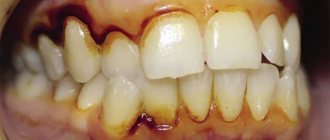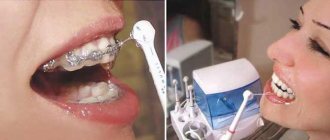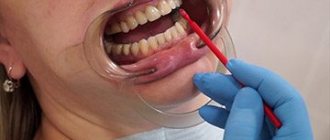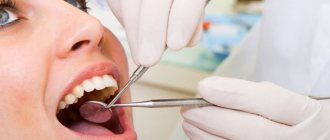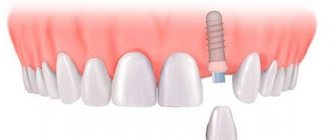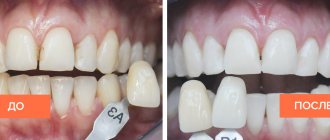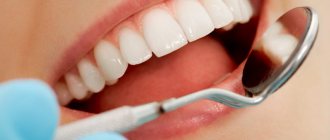Our enamel is constantly exposed to aggressive external factors, such as coloring products, coffee and tea, medications, and tobacco smoke. All this over time leads to a gradual change in the color of the teeth, the formation of abundant yellow plaque, which over time turns into hardened deposits that provoke the development of caries. Today, the Vita tooth color scale is actively used in dentistry - it is used to determine the shade of enamel, predict the results of whitening, and select the appropriate tone for filling materials. Later in this article we will talk about what this scale is, when it is used and how to use it correctly.
What factors determine the natural color of enamel?
Before moving on to the technique of using the Vita scale in dentistry, let’s consider what the natural shade of teeth depends on and what affects their color. Several factors play a decisive role in this issue, and here are the main ones:
- heredity,
- predisposition to certain systemic pathologies,
- level of hygiene,
- diet,
- condition and strength of bone tissue.
If we talk about what tone of teeth is considered normal, then we must immediately make a reservation that the enamel consists of approximately 97% of inorganic compounds. Therefore, its natural color is different for everyone, despite the fact that a person may not have any pronounced dental problems.
Heredity primarily determines the color of teeth
A change in the color of the enamel, its yellowing should be a good reason for concern and contact a specialist. After all, poor hygiene and plaque are not the only reasons for visible changes, and the real problem may lie much deeper. The reason may be not only dental disease, but also systemic pathologies.
What determines the natural color of tooth enamel?
What the natural color of teeth should be is directly dependent on the shade of their enamel. The latter shade is largely determined by heredity. In most cases, tooth enamel is milky white or translucent. It should also be taken into account that the tissues of the same tooth have different colors; the cutting edge is lighter than the root part. An interesting fact is that the natural color of the front teeth is different - the canines are darker than the incisors. The following factors also affect the natural color of teeth:
- enamel density - dentin “shines through” through thin enamel, and this layer is naturally yellowish,
- tooth microrelief - the more pronounced it is, the whiter the tooth color looks,
- quality of dentin - with age (or due to a number of other factors) it darkens, sometimes the pulp, which has a red-brown color, begins to “shine through” it.
For what reasons can the shade of teeth change?
A naturally perfect snow-white smile is quite rare. In addition to the fact that most people’s teeth have a slight yellowish tint from birth, throughout their lives they are constantly exposed to external factors that cause their color to change. Here are just the main prerequisites:
- improper and irregular cleaning,
- addiction to coffee, strong tea and other coloring drinks,
- smoking cigarettes,
- aging of the body,
- dental diseases,
- consumption of products with intense coloring pigments,
- lack of vitamins and microelements or their excess in the body,
- taking certain medications.
Constant exposure to external factors causes changes in the color of teeth
. To maintain the natural whiteness of a smile, you need to follow the rules of oral hygiene, respond in time to any suspicious changes, and regularly visit the dentist’s office for preventive examinations.
What can you learn about health from the color of your teeth?
“As for the color of teeth, we can use it to determine whether a person had any problems in childhood. For example, there is such a term in dentistry as “tetracycline teeth.” If a child is sick and is prescribed tetracycline antibiotics, and at this time his permanent teeth are developing, tetracycline is deposited in the developing teeth. Because of this, their structure changes somewhat, and the enamel acquires a specific gray-brown tint. Such teeth cannot be called sick, but they cannot be called healthy either: the structure of the tooth contains elements of the antibiotic tetracycline,” says Ryzhova.
Article on the topic
Like from Hollywood! Teeth whitening methods
According to her, a specific plaque, due to which the enamel changes its natural shade, can be an indicator of various diseases of the gastrointestinal tract and increased stomach acidity. By the nature of dental plaque, you can also find out whether patients have any bad habits: for example, whether they smoke (in this case, the teeth turn yellow).
As Ryzhova explains, in a sense, the light shade of teeth can be considered a sign of their health, because there is no plaque. “Teeth affected by caries may be darker: due to pigments appearing in the carious cavity, the teeth become darker. That is, healthy teeth are light, without excess plaque. Moreover, they should not be boiling white at all, like ceramics,” says the expert. Ryzhova notes that a lot depends on heredity: some were born with darker teeth, others with lighter ones. “The criterion for healthy teeth is not so much the color as high-quality oral hygiene, the absence of bad habits and regular visits to the dentist to avoid caries,” she says.
Vita scale - what is it?
The Vita scale is a ruler of visual perception of different shades of enamel, in which each tone is assigned an alphanumeric designation. This table is the most popular tool for determining the color of teeth in dentistry both in Russia and in European countries. The scale itself is divided into 4 groups: A, B, C and D. The palette includes 16 shades. As part of professional whitening or prosthetics, the specialist first evaluates the current clinical picture, after which he selects the closest shade from the proposed range.
On a note! In modern clinics, digital technologies are used for this purpose, for example, the Digital Smile Design program. This is innovative software that allows you to project the appearance of your smile after restoration and carefully plan the upcoming treatment, including determining the most suitable enamel tone. Images of the patient’s jaw system from different angles are loaded into the program, where they are further processed and the future smile is modeled.
The Vita scale can be presented in the form of a palette printed on thick laminated cardboard, plastic or paper. But the best option is a table with retractable acrylic microprostheses made of ceramics. This device is used when choosing the color of a composite material for artistic restoration, the shade of a future crown, in the manufacture of veneers and lumineers, and for whitening.
Thus, the scale offers the following palette of tones:
- A (1, 2, 3, 3.5, 4) – five options of red-brown shade,
- B (1, 2, 3, 4) – four subtones of red-yellow,
- C (1, 2, 3, 4) – four shades of gray,
- D (2, 3, 4) – three subtones of red-gray1.
The Vita scale can be presented in the form of a palette
Now about brightness: the higher the index, the dimmer the color. The lower it is, the lighter and brighter the samples will be. So, for example, under the designation A1 will be the lightest shade, while under A4 will be the darkest shade from this category.
How to choose teeth color
There are certain situations when dental treatment and prosthetics require choosing the right tooth color. At the same time, there are several parameters that the prosthetist dentist must take into account when giving recommendations to his patient regarding the choice of color for composite restorations and denture structures:
- If several teeth are missing, then the color of their analogues should match the patient’s natural teeth. First of all, they focus on the neighboring teeth, then on the more distant teeth of the jaw that is subject to prosthetics. Lastly, attention is paid to the teeth of the other jaw, which are located in the prosthetic area.
- It should be taken into account that the color of solid ceramics, zirconium dioxide, metal-ceramics and acrylic (plastic) teeth differ in shine and brightness.
- If the patient has no teeth left at all, then any tooth color can be chosen, but it is best to focus on the color of the whites of the eye; teeth that are much whiter than the whites of the eye look a little unnatural.
The conditions in which it is best to choose the color of future dental crowns and bridges, which should match your teeth, are as follows:
- The patient's lips should be without colored lipstick
- The light in the room should be daylight
- The patient's clothing should not be brightly colored
In what cases is the Vita scale used - recovery methods
The Vita color scale allows you to evaluate the actual shade of enamel and identify possible deviations from the norm. This is a kind of hint that helps to assess the current clinical picture. This tool is used before whitening, restoration, prosthetics, installation of veneers and lumineers. Here are the main options for restoring the natural whiteness and beauty of a smile, for which the Vita palette is usually used:
- professional hygiene – removal of plaque and tartar in the dentist’s office, allows you to eliminate pathological lesions at their very beginning, as well as restore the natural color of the enamel,
- home whitening is a set of techniques that involve the use of special gels, ointments, pastes, trays and pads impregnated with a whitening composition. Such techniques make it possible to lighten the enamel by several tones, but the effect cannot be called long-lasting,
- in-office whitening - photo whitening, laser, sandblasting, ultrasonic, intracanal, etc. Each technique has its own pros and cons, indications and contraindications. In any case, a professionally performed procedure allows you to achieve a pronounced and long-term effect,
- orthopedic restoration, including microprosthetics - this category includes artificial crowns, dentures, veneers and lumineers. Here we are talking not just about lightening the enamel, but also about correcting other defects, for example, chips and cracks, partially destroyed elements.
The scale allows you to evaluate and select the true shade of enamel
“When I was getting veneers, I had a lot of trouble with these colors. She herself is blonde and has fair skin, so there were specific problems with the choice of shade. At first one dentist suggested A1, but I thought it was a bit too much. As a result, with another doctor we settled on A2 - it looks more natural. In artificial light there is no feeling that your smile is porcelain. I’m very pleased that I went to another specialist and chose this option.”
NinaKom., Moscow, from correspondence on the woman.ru forum
The choice of a specific technique directly depends on the clinical picture, the desired effect, the cause of dental problems, as well as the financial capabilities of the patient. If it's just a matter of yellowed enamel, don't rush to self-medicate. Even before starting at-home whitening methods, you should consult with your dentist.
What is the scale
To determine the shade of enamel, dentists use a special table. In fact, the Vita scale is a simple list with images that simplifies the visual perception of the color of teeth, with letters and numbers. This table is commonly used not only in Russia, but throughout Europe.
The Vita Tooth Color Chart is the most popular tool used by dentists around the world. It is produced in various types and from different materials:
- paper;
- plastic;
- laminated cardboard;
- ceramics.
Visually, this device is a kind of rail to which several categories of tooth models are attached, differing from each other:
- A – red-brown colors.
- B – red-yellow.
- C – gray.
- D – red-gray.
In addition, to the right of the indicated letters there are also numbers that indicate brightness: 1 is the most saturated color, and 4 is the dimmest. Thus, according to the Vita scale, the letter variety of the shade is first determined, and then its digital designation.
Technique for determining color - how to choose the right shade
So, we found out that the Vita scale is used to determine what color a person’s teeth are and how to choose a shade during dentures or before lightening. But to correctly assess the condition of the enamel, the correct inspection technique is required. Below we will take a closer look at how the tone of teeth is determined and the shade closest to it is selected from the scale.
Preparing for a Smile Appearance Assessment
Before comparing enamel with the Vita palette, the patient must thoroughly clean his teeth of plaque and stone. However, more often than not this is not enough. Therefore, it is necessary to additionally carry out professional cleaning of dental plaque to restore the natural shade.
Before assessing color, you need to have your teeth professionally cleaned.
What factors influence color perception?
To properly assess tone, the inspection must be carried out under certain conditions. Thus, the results may be distorted due to incorrect lighting, poor quality of cleaning the enamel from plaque, the presence of foci of inflammation and other dental problems. Therefore, such diagnostics also require careful and attentive preparation.
Optimal conditions for the procedure
When answering the question of how to calculate how many shades your teeth have changed their color, you need to thoroughly clean them first. At the same time, fluorescent lamps must be installed in the dental office. The patient is advised not to wear bright clothes - it is better to give preference to calm pastel colors that will not create a sharp contrast.
The inspection must be carried out under certain conditions
Advice from Dr. Zubastik
Don't like the color of your teeth? Don't worry, the problem can be solved. If you wish, you can buy a special set of mouth guards and lightening gel and lighten the enamel at home.
But first, consult your doctor: he may advise you to limit yourself to ultrasonic cleaning. In this case, the teeth will become half a tone whiter.
If it’s not enough, use a professional whitening service or install veneers. The main thing is that in pursuit of beauty, do not forget about dental health. Frequent bleaching weakens the enamel. Maybe it’s better to agree with what nature gave - after all, yellowish enamel is really a little stronger than ideal white?
Do you want to lighten your enamel? Watch how it happens:
Tags: Baby teeth, whitening, Teeth color, Vita scale
About the author: Dr. Zubastik
Typically, a toothache begins to subside on the way to the clinic and finally goes away after 10 minutes of sitting in line to see the dentist.
- Related Posts
- 10 foods that are good for your teeth
- Why do children need restoration of baby teeth?
- Have your teeth whitened? Let's follow the white diet!
« Previous entry
Preventive measures
If over time your smile has yellowed, your teeth have become dull and stained, in some cases you can do without in-office whitening and veneers. To do this, it is enough to undergo a professional cleaning procedure in the dentist’s office and subsequently provide competent prevention:
- give up bad habits, reduce consumption of coffee, strong tea and coloring products,
- maintain a high level of hygiene, brush at least twice a day, rinse your mouth every time after eating, use floss,
- start treatment of emerging dental problems in a timely manner and undergo preventive examinations at least twice a year.
Using hygiene products will help preserve the color of the enamel.
If the cause of the darkening has more serious justifications, you will need to undergo a full diagnosis in order to identify the true causes of the problem and then work directly with them. Professional whitening, microprosthetics or installation of crowns/prostheses will help correct the aesthetic defect.
Correctly selected color is a guarantee that the dentition will be aesthetically pleasing.
If the patient plans to regularly resort to whitening, the implant should be installed after the procedure so that its shade is not too dark. However, it will be impossible to neglect regular visits to the doctor and preventive professional cleaning , otherwise the artificial tooth will be a “light” spot in the mouth.
Proper oral hygiene helps maintain the light shade of enamel and its density. Use a quality toothpaste tailored to your needs, and not just rely on commercials that promise a “snow-white smile in just 14 days.” Don’t forget that the brush is no less important - it needs to be changed at least once every couple of months, stored strictly vertically with the head up, preferably in a case, and washed with warm water and soap before first use.
And, of course, you need to visit the dentist regularly. Professional teeth cleaning will help keep your teeth white , during which the doctor removes deposits from the surface of the enamel, stone and plaque. Compliance with the doctor’s recommendations plays a big role. So, after a whitening or cleansing session, you will need to give up coloring drinks and foods for some time - vegetable soups with tomatoes and beets, red wine, grape juice, and so on.
What healthy children's teeth should look like
Healthy baby teeth should be white and slightly translucent. Their formation begins in the sixth week of intrauterine development, and by the time the baby is born, all 20 rudiments should already be fully formed and waiting in the wings. Here, a lot depends on the woman’s health during pregnancy, so the expectant mother needs to carefully monitor her condition, eat right, treat emerging health problems in a timely manner, and, if possible, avoid taking potent medications.
Healthy baby teeth should be white and slightly translucent
So, for example, long-term use of tetracycline antibiotics during pregnancy leads to pronounced staining of the dental tissues of both mother and baby. As a result, the enamel acquires a rather bright yellow tint, which is very difficult to lighten.
Color of baby teeth
Normally, the color of a child’s baby teeth is white and transparent. Various deviations in the coloring of temporary teeth indicate mineralization disorders, caries and other diseases. The formation of primary teeth occurs at the 6th week of pregnancy, and by the time of birth the baby has fully formed rudiments of all 20 primary teeth. Taking certain medications, for example, tetracycline antibiotics, leads to dark staining of children's teeth; so-called tetracycline teeth appear, which practically cannot be whitened. Therefore, during pregnancy it is necessary to consult with specialists about taking certain medications.
0%
Installment plan without overpayments
Whiten your teeth today!
Take advantage of interest-free installments for 2 years without a down payment
Find out more
8
Payment by installments is possible without bank participation
What to do if your tooth color has changed
If a tooth suddenly darkens or acquires an uncharacteristic shade, it is probably due to pathological processes that require immediate help from specialists. You cannot delay with such a symptom - you need to contact a dentist as soon as possible so that he can assess the degree of deviation from the norm and diagnose the cause of the pathological phenomenon. A tooth can suddenly darken as a result of injury, the development of necrotic processes in the pulp area, or due to the presence of filling material containing silver, tin, mercury or zinc (obsolete materials).
Changes in enamel color indicate some pathological processes
If we talk about changing the color of the entire smile at once, then among the common prerequisites for the problem are work in the metallurgical industry, excessive consumption of coffee, strong tea, coloring products, smoking, taking powerful medications, and low levels of hygiene. In any case, such a situation requires increased attention and mandatory examination by a specialist. Even if it's all about poor hygiene or excessive coffee consumption, it's imperative to have a hygienic cleaning at the dentist's office. Otherwise, plaque will soon turn into hard deposits and become a prerequisite for the development of carious processes.
Aesthetic restoration of tooth color
To correct the color of teeth, modern dentistry offers several methods that solve the problem of stained teeth with varying degrees of effectiveness. The fastest and cheapest methods are to use pencils and dyes to mask the dark color of teeth. You can simply paint your dark teeth white. True, such an update is enough for a maximum of a day.
For longer periods, you can use different dental whitening options, ranging from home whitening to laser whitening. The results can last for several years.
A radical solution to the problem of poor color of your teeth is possible by installing ceramic veneers or lumineers, as well as ceramic crowns and zirconium dioxide. In this option, the light color of the teeth will remain for a period of 10 to 20 years.
Our doctors
Brodsky Sergey Evgenievich
Deputy Chief Physician, Candidate of Medical Sciences, specialties: dentistry and medical microbiology.
Work experience: since 1999.
Salatsky Dmitry Nikolaevich
Chief physician, orthopedic dentist, gnathologist, maxillofacial prosthetist.
Work experience: since 1988.
Shirinyan Sarkis Kimovich
Dentist, implant surgeon, orthopedist, therapist
Work experience: since 2000.
Skranzhevskaya Svetlana Vladimirovna
Hygienist, dental assistant
Work experience: since 1994
Seredin Evgeniy Vasilievich
Implant surgeon
Work experience: since 2004
Malanova Olga Andreevna
Dentist, orthodontist, therapist
Work experience: since 2020
Rybakova Tatyana Evgenevna
Dentist-therapist-endodontist
Work experience: since 2006
Molodtsov Dmitry Evgenievich
Osteopathic dentist
Work experience: since 1998
Artemyeva Oksana Alexandrovna
Orthopedic dentist, therapist
Work experience: since 2001
What is the relationship between enamel color and systemic diseases
Poor hygiene and dental diseases are not the only factors leading to darkening of the enamel. So, for example, such a nuisance can occur due to disruptions in fluoride metabolism in the body, with some systemic diseases and heavy metal poisoning. If we talk about dental pathologies, then fluorosis leads to the appearance of dark spots on the teeth, and the pulpless units completely darken from the inside.
Changes in the color of the enamel may indicate serious diseases of the body
If hard tissues have acquired a reddish tint, this may indicate internal disorders, such as rheumatism, porphyria, infectious pathologies: typhoid, cholera, dysentery. The condition of teeth also worsens with diabetes mellitus, as well as other disorders of the endocrine system.
Modern dental clinics offer all possibilities for correcting the shade of enamel: from professional and endodontic whitening to the installation of veneers or crowns. But it is better, of course, to initially maintain oral hygiene, monitor the health of your teeth and gums, and undergo regular preventive examinations with a dentist in order to protect yourself from many dental problems.
- Vavilyuk A A. Teeth whitening: what you need to pay attention to when choosing different systems, 2004.
Reasons for color change
Changing the color of teeth occurs under the influence of internal or external factors. In the first case, we are talking about darkening or pigmentation of dentin - it will be difficult to restore the natural shade of enamel in such a situation. External factors primarily contribute to the staining of enamel - most whitening technologies are aimed at eliminating “contaminants” of this particular type. The most common reasons causing changes in enamel shade are presented in the table.
| Reasons for color change | Examples | Features of teeth shade |
| Injury | Fall, impact, other damage. | The enamel of the affected tooth becomes black or gray. |
| Nerve death | The dead nerve in the canal causes the tooth to darken from the inside. | |
| Materials of artificial origin in the dental element | Collapsed/defective dentures, fillings made using metal alloys. | Stains of yellow, green, brown, grey, blue or black on treated and filled teeth. |
| Genetics | Hereditary predisposition to color abnormalities. Experts identify 140 genetic syndromes and diseases that cause defects in tooth enamel. | Pigmentation may be slight, and sometimes the enamel becomes abnormally colored. Often requires microprosthetics with veneers. |
| Age | Over time, the enamel thins and the dentin darkens, so older people's teeth appear dark. | Red-yellow or red-brown enamel color. |
| Natural dyes | Substances from drinks and food, as well as those released when smoking, can stain tooth enamel. | Spots of green, yellow, orange, brown. |
| Fluorine | Fluorosis. | Spots and stripes of a chalky or brown hue. |
| Taking medications | Antibiotics of the tetracycline group. | Gray-blue or brownish-yellow stripes, usually running horizontally. Whitening is difficult; installation of veneers or crowns is recommended. |
READ ALSO: Tooth enamel: restoration and strengthening at home
Discoloration of teeth - causes and treatment of yellowness and stains on teeth
In today's society, which places so much emphasis on youthful and attractive appearance, dull and dirty teeth that have lost their natural color are becoming a common complaint among dental patients. In addition to professional teeth whitening technologies such as Brite Smile, Opalescence and Zoom whitening, people are using new products every day in the ongoing battle against yellow discoloration and other signs of tooth discoloration. People use a variety of products to achieve and maintain a white, attractive smile, from at-home whitening strips and bleach containers to whitening toothpastes and chewing gums.
Types of tooth discoloration
There are two main types of tooth loss of natural color: external and internal.
- External discoloration occurs in the outer layer of the tooth called the enamel; damage to the color of the enamel is expressed in white stripes, yellow impurities, brown areas and dips;
- Intrinsic discoloration occurs in the inner tissue of the tooth, called dentin. It darkens or becomes covered with yellow or gray spots.
While external discoloration can be effectively treated with various whitening technologies, internal discoloration is more difficult to treat. It may require alternative aesthetic methods such as veneers.
Causes of tooth discoloration
To effectively deal with the loss of natural tooth color, it is important to determine the causes of this phenomenon. Among them:
- Food and drinks: Coffee, tea, cola, wine and certain foods (eg eggs, cherries, blueberries) can cause internal tooth decay;
- Tobacco use: Smoking or chewing tobacco spoils the appearance of teeth;
- Poor oral hygiene: Improper brushing and flossing that does not remove tartar and discoloration substances can cause this unpleasant syndrome;
- Diseases: Diseases affecting enamel and dentin can cause teeth to lose their natural color. Certain infections in pregnant women can cause newborns' teeth to discolor, affecting the development of their tooth enamel;
- Medications: Antihistamines, antidepressants, and high blood pressure medications can damage teeth. The use of tetracycline antibiotics by pregnant women in the second half of the term can lead to the loss of the natural color of the baby’s tooth enamel. Children taking the antibiotics tetracycline and doxycycline before permanent teeth develop, i.e. up to eight years of age, may suffer from internal discoloration of permanent teeth.
- Dentures: Procedures that require the use of certain artificial materials, such as silver amalgam, can give teeth a grayish-black appearance;
- Aging: As we age, tooth enamel wears away, revealing the natural yellow color of dentin. In addition, with age, teeth accumulate more and more stains and tartar, as a result of which they lose their natural color and darken;
- Genetic predisposition: Some lucky people have brighter and/or thicker tooth enamel than others;
- Environment: Excessive amounts of fluoride, such as in drinking water, and increased consumption of fluoride-based substances, especially toothpaste and other oral products, can cause teeth to lose their natural color.
- Medical procedures: Certain procedures can affect the color of enamel and dentin as a side effect. These include, for example, chemotherapy.
- Injuries: Falls or other injuries that damage the dental nerves or the teeth themselves also damage the teeth of both children and adults.
Causes of tooth discoloration
The color of stains on teeth depends on what caused it. Factors that cause teeth to lose their natural color and the types of stains that appear on teeth are:
- Tetracycline antibiotics: Tooth discoloration caused by tetracycline and other antibiotics usually results in teeth turning bluish-gray or yellowish-brown, often in the form of horizontal streaks. Porcelain veneers are well suited for treating this syndrome.
- Fluorine. Fluorosis, the overuse of fluoride during the formative years of teeth, often results in chalky white or brown areas, spots or streaks on the surface of the tooth. Although brown spots respond well to sanding, white spots do not. But you can whiten your teeth in general, and against the background of a bleached surface, these painful white spots will not be so noticeable. In some cases, bleaching can be combined with bonding materials or abrasive technologies to address problematic white spots. For example, enamel microabrasive is a concentric application of an ultra-fine, gritty paste containing a tooth-safe acid and is used to remove areas of internal discoloration caused by fluorosis and decalcification caused by braces or bands.
- Food, Drinks and Tobacco: Coffee, tea, cola and red wine leave stains on teeth over time that turn into yellow, brown, green and orange stains. These types of dental stains can usually be removed with regular deep cleaning and home care. The latter consists of brushing your teeth, flossing them and rinsing after each meal. Of course, the consumption of foods and drinks that cause such color abnormalities should be stopped or significantly limited. Peroxide-based whitening technologies, as well as home-use bleaches such as toothpastes, rinses, strips and chewing gums, also work well with these types of stains. They can be recommended in addition to stationary whitening procedures.
- Aging: Over time, teeth become yellow or brown. Stationary and home whitening will provide significant results. For best long-term results, periodic repetition of treatments is recommended.
- Genetic Predisposition: Just like your body shape and eye color, your teeth are also influenced by the genes you inherit. Therefore, teeth with natural color anomalies may be almost or completely resistant to whitening technologies. In these cases, your dentist may recommend veneers or composites.
- Poor oral hygiene and tooth decay: Your teeth may develop stains that are whitish, grey, brown, yellow, or even black or green. Bleach will not help with such stains. In these cases, the dentist can stop tooth decay with restorative procedures such as fillings, crowns, or veneers.
- Artificial materials in teeth: Defective or decaying dentures can also cause grey, brown, black, yellow or green stains on the teeth. Also, white fillings will darken over time, and this is normal. Metal fillings, even if they are not directly visible, can be visible through the translucent tissue of the tooth. For example, blue, gray and black stains are often caused by materials including amalgam, glass ion resins, acrylic and porcelain that cover metal crowns. Bleaching will not change the color of artificial materials. In these cases, the dentist may recommend replacing these materials after whitening.
- Trauma and root canal treatment: Injuries caused by falls and other accidents, as well as root canal treatment, can cause tooth tissue to become damaged and appear gray or black in color. Stains appear only on those teeth that are directly affected. In some cases, this discoloration may indicate the death of the nerve located inside the tooth. Because using bleach may lighten a tooth with a dead nerve inside, it will not solve the underlying problem that needs to be addressed to avoid severe pain or more severe dental problems later. If your tooth is darkened due to a root canal, enamel whitening will again not help. The dentist may apply a whitening material to the inside of the tooth or suggest a crown or veneer. In cases where the tooth is chipped or severely damaged, the dentist may also recommend a crown or veneer.
Treatment of tooth discoloration
[google]
Treatment options for discolored teeth vary depending on the cause of the problem. Before developing a treatment plan, your doctor must conduct a comprehensive examination of your health. General medical conditions, such as tooth decay or gum disease, require treatment before undergoing aesthetic procedures.
Tooth discoloration is treated in the following ways:
- Maintaining proper hygiene: Maintain dental hygiene by brushing and flossing daily. You should undergo a professional teeth cleaning procedure at least once every six months. It is needed to remove surface contaminants and bacteria, and its exact frequency will be determined by the dentist’s recommendations. Use a supersonic toothbrush, which is more effective at removing food debris that causes discoloration on both sides of your teeth.
- Teeth Whitening: These procedures fall into four categories:
In-patient whitening: The dentist can effectively treat external as well as internal tooth discoloration caused by certain foods, drinks, and other causes by treating tooth enamel with a hydrogen peroxide-based whitening gel. This process usually takes an hour and costs an average of $650 per visit. If a laser or other special lighting equipment is used to speed up the process, for example, a ZOOM , the cost increases. Patients with stained teeth that are particularly difficult to remove may need several whitening sessions. The dentist may also recommend an at-home whitening kit for such a patient.
Prescription At-Home Whitening Kit: Many dentists believe that the best results over time can be achieved with a prescription at-home whitening kit. Such kits are more suitable for treating external color disorders. They consist of bleaches, gels or strips. These typically include custom or standard dental containers and whitening gel. This gel, based on inpatient versions but with reduced hydrogen peroxide content, is placed in dental containers and worn daily for at least an hour (and sometimes left in the mouth overnight) for a week or two, depending on the desired results. These at-home whitening kits cost $100-$500.
Over-the-counter at-home whitening kits:
Over-the-counter at-home whitening kits are a cost-effective alternative to other tooth discoloration treatments without requiring a doctor's supervision. These over-the-counter products contain reduced levels of bleach and are sold in supermarkets, pharmacies and online. They can be rinses, liquids for applying to the surface of teeth, toothpastes, chewing gums and whitening strips. However, the last three forms of bleach are designed to remove surface stains. Rinses and brushing ointments with reduced hydrogen peroxide have some whitening effect; strips provide similar results. Such drugs cost from 4 to 100 dollars.
Other whitening methods that don't require a visit to the dentist: More and more whitening kits are now available in retail stores - at drugstores in shopping malls, in salons and spas, and even on cruise ships and airports. They are sold by pharmacists who do not specialize in dentistry. These kits range from $99 at kiosks at malls and airports to about $200 at salons, spas and cruise ships.
Composite fillings, crowns and veneers: For teeth that have lost much of their natural color due to excessive amounts of fluoride, root canal treatment, tetracycline or other medications, the dentist may not recommend bleaching, but rather the application of a composite bonding material to the outer surface of the teeth of the desired type. color, porcelain veneers or crowns. Composite rubber veneers, which cost about $250 per tooth, are placed directly on the teeth and then molded into the desired shape and shade. Porcelain veneers, which are thin shells of porcelain bonded to the front of teeth, cost between $900 and $2,500 per tooth. Lumineers, i.e. Another type of porcelain veneers, made from Cerinate brand porcelain, cost between $700 and $1,000 per tooth. Porcelain crowns, also called caps, cost $600 to $3,100 per tooth. Consult with your dentist to determine which tooth color restoration options are best for your specific case.
Prevention and maintenance of proper dental health
Teeth loss of color can be prevented by following a certain lifestyle and maintaining white teeth after the whitening procedure. For example, avoid foods and drinks that damage teeth and excessive doses of fluoride. If you drink coffee and/or tobacco, give them up or at least reduce your consumption. Rinse your mouth after drinking wine, coffee and other drinks and foods that adversely affect the color of your teeth. Internal tooth discoloration, caused by damage to the dental nerve or blood vessels, can be prevented by root canal treatment and removing the inner part of the tooth, called the pulp, before it decays and darkens.
Additional Tips
Whitening is indicated mainly for patients whose teeth have acquired an external color of yellow, orange or light brown, including due to contamination with chlorhexidine. Bleaching can also help remove minor internal stains caused by tetracycline and fluorosis.
Stationary enhanced whitening is performed using hydrogen peroxide with a concentration of 15-40% and light treatment and should be performed by a dental specialist. At-home whitening kits, which can be used with or without in-patient whitening, contain lower concentration solutions and produce gradual results over a longer period of time.
Whitening toothpastes containing no more than 1% peroxide are minimally effective for treating minor tooth discoloration. For darker stains, the best results are achieved by combining stationary and home bleaching. It is also usually necessary to repeat these procedures regularly.
Some external contaminants can be removed by ultrasonic cleaning, concentric polishing with abrasive maintenance paste or air-blast polishing with abrasive powder. Please note, however, that these methods can lead to enamel erosion, so we do not recommend using them often.
Consultation with doctors and professional services may be required if the change in natural tooth color occurs due to internal reasons and is due to a chronic disease. To assist in treatment, the services of an endodontist, prosthetist, periodontist, oral and maxillofacial surgeon may be needed.
Tags: dental diseases, teeth cleaning
Previous post
Opalescence teeth whitening: let your smile be even brighter!
Next entry
